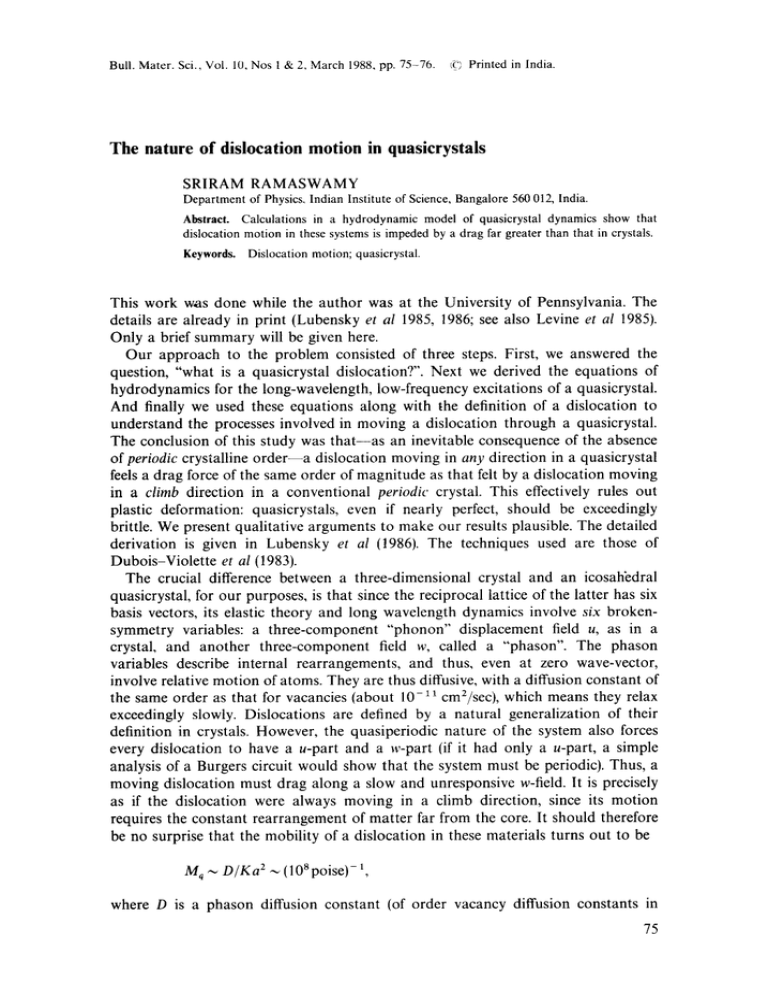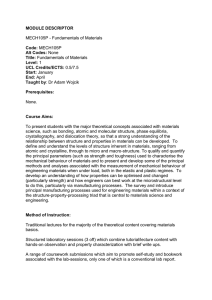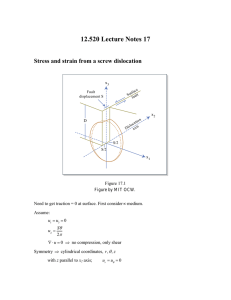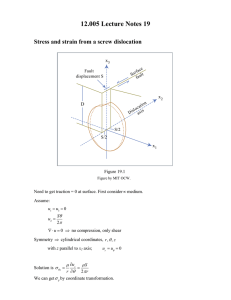The nature of dislocation motion ... SRIRAM RAMASWAMY
advertisement

Bull. Mater. Sci., Vol. 10, Nos l & 2, March 1988, pp. 75-76.
c(') Printed in India.
The nature of dislocation motion in quasicrystals
SRIRAM RAMASWAMY
Department of Physics, Indian Institute of Science, Bangalore 560 012, India.
Abstract. Calculations in a hydrodynamic model of quasicrystal dynamics show that
dislocation motion in these systems is impeded by a drag far greater than that in crystals.
Keywords. Dislocation motion; quasicrystal.
This work was done while the author was at the University of Pennsylvania. The
details are already in print (Lubensky et al 1985, 1986; see also Levine et al 1985).
Only a brief summary will be given here.
Our approach to the problem consisted of three steps. First, we answered the
question, "what is a quasicrystal dislocation?". Next we derived the equations of
hydrodynamics for the long-wavelength, low-frequency excitations of a quasicrystal.
And finally we used these equations along with the definition of a dislocation to
understand the processes involved in moving a dislocation through a quasicrystal.
The conclusion of this study was that--as an inevitable consequence of the absence
of periodic crystalline order--a dislocation moving in any direction in a quasicrystal
feels a drag force of the same order of magnitude as that felt by a dislocation moving
in a climb direction in a conventional periodic crystal. This effectively rules out
plastic deformation: quasicrystals, even if nearly perfect, should be exceedingly
brittle. We present qualitative arguments to make our results plausible. The detailed
derivation is given in Lubensky et al (1986). The techniques used are those of
Dubois-Violette et al (1983).
The crucial difference between a three-dimensional crystal and an icosah~dral
quasicrystal, for our purposes, is that since the reciprocal lattice of the latter has six
basis vectors, its elastic theory and long wavelength dynamics involve six brokensymmetry variables: a three-component "phonon" displacement field u, as in a
crystal, and another three-component field w, called a "phason". The phason
variables describe internal rearrangements, and thus, even at zero wave-vector,
involve relative motion of atoms. They are thus diffusive, with a diffusion constant of
the same order as that for vacancies (about 10-it cm2/sec), which means they relax
exceedingly slowly. Dislocations are defined by a natural generalization of their
definition in crystals. However, the quasiperiodic nature of the system also forces
every dislocation to have a u-part and a w-part (if it had only a u-part, a simple
analysis of a Burgers circuit would show that the system must be periodic). Thus, a
moving dislocation must drag along a slow and unresponsive w-field. It is precisely
as if the dislocation were always moving in a climb direction, since its motion
requires the constant rearrangement of matter far from the core. It should therefore
be no surprise that the mobility of a dislocation in these materials turns out to be
M,~ ,,~ D / K a z ~
(108 poise) - 1,
where D is a phason diffusion constant (of order vacancy diffusion constants in
75
76
Sriram Ramaswamy
crystals), K is an elastic constant, and a is a unit cell size. By contrast, the mobility
for olide in periodic crystals is
Mc ~ ~/- 1 ~ (1 poise)- 1,
where r/is a "crystal viscosity", i.e. a sound damping coefficient.
The main consequence of this, as discussed earlier, is that plastic deformation
should be practically impossible. It also probably means that the process of
annealing out phason and dislocation strains in quasicrystals should be very slow,
and that therefore even large single grains should have short translational
correlation lengths. This seems to be in accord with recent experiments (Horn et al
1987).
References
Dubois-Violette E, Guazzelli E and Prost J 1983 Philos. Mao. A48 727
Horn P M, Heiney P A, Bancel P A, Gayle F W, Jordan J L, LaPlaca S and Angilello J 1987 Science (to
appear)
Levine D, Lubensky T C, Ostlund S, Ramaswamy S, Steinhardt P J and Toner J 1985 Phys. Rev. Lett. 54
1520
Lubensky T C, Ramaswamy S and Toner J 1985 Phys. Rev. B32 7444
Lubensky T C, Ramaswamy S and Toner J 1986 Phys. Rev. 1333 7715






